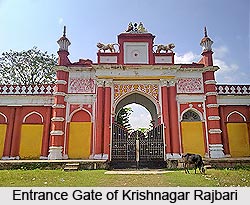 Tourism in Krishnanagar covers the archaeological sites, medieval and the modern temples. Some of the pilgrimage tourism sites are Krishnanagar Palace or Kirshanagar Rajbari, Ghurni, Mayapur, Nabadwip.
Tourism in Krishnanagar covers the archaeological sites, medieval and the modern temples. Some of the pilgrimage tourism sites are Krishnanagar Palace or Kirshanagar Rajbari, Ghurni, Mayapur, Nabadwip.
Krishnanagar is a significant hub for culture and literature of medieval and modern times. The local population of the city of Krishnagar continues to engage in a vivacious culture of literary exchange. Krishnagar has a sub-urban locality called Ghurni. The dolls of Krishangar are famous not only in West Bengal, but also in other places of India.
Krishnanagar Palace or Krishnagar Rajbari
Krishnagar Rajbari also known as the Krishnanagar Palace is most widely visited architectural wonder in this suburb city. This palace is mostly visited for the celebration of different festivals like Jhulan Mela, Holi, Baro Dol and Durga Puja. Here Durga Puja is celebrated with its own grandeur.
Religious Temples and Monasteries of Krishnagar
The religious temples and monasteries in Krishnanagar are an integral part of the city tourism. Jalangi ghat is a popular tourist destination along with religious destinations like Mayapur, Nabadwip and Shantipur. A few other attractions include the College Bhavan and the Public Library.
Roman Catholic Church
Roman Catholic Church is located in Krishnanagar. This Catholic Church is famous for its distinctive and appealing architecture. It stands out and tourists of all races, religious and ethnicities frequent this church that explains the life and time of Jesus Christ in the inception, through European paintings and carvings in the walls. The compound also houses a protestant church.

Mayapur
Mayapur is also known as the spiritual capital of Indian state of West Bengal. Iskcon Temple at Mayapur for years has attracted tourists from the world over. The International Society for the Krishna Conscious is a close knit group of spiritual enthusiasts.
Nabadwip
Nabadwip is a suburb place in Krishnagar. In Bengali, Nabadwip means nine islands and is an eastern town in the state of West Bengal and is close to Bangladesh. The names of the islands are as follows; Antardwip, Simantadwip, Rudradwip, Madhyadwip, Godrumdwip, Ritudwip, Jahnudwip, Modadrumdwip, and Koladwip. Nabadwip is a place of spiritual significance and pilgrims from all over the world come down and celebrate the Nabadwip Mandala Parikrama which involves a pageant while chanting religious verses dedicated to the love life of Lord Krishna and Radha. Guru Purnima and Rash Purnima celebrated on a full moon day are also of importance here.
Ghurni
Ghurni is a neighbourhood of Krishnanagar in Nadia district of West Bengal. It is the centre for manufacturing clay dolls. The clay dolls of Ghurni are often referred to as Krishnanagar clay dolls.
 The old name of Krishnanagar was Rewe. In the early 17th century, Bhabananda Majumdar founded the royal family of Nadia. Later, Maharaja Rudra changed the name to Krishnagar. In 1757, Maharaja Krishnachandra helped the British East India Company against Siraj-Ud-Daulah in the Battle of Plassey. He was a great patron of arts, including literature and music, and supported the production of clay dolls. In the year 1728, Maharaja Krishnachandra brought families of potters from Dhaka and Natore (now in Bangladesh) and settled them in Ghurni, then a village.
The old name of Krishnanagar was Rewe. In the early 17th century, Bhabananda Majumdar founded the royal family of Nadia. Later, Maharaja Rudra changed the name to Krishnagar. In 1757, Maharaja Krishnachandra helped the British East India Company against Siraj-Ud-Daulah in the Battle of Plassey. He was a great patron of arts, including literature and music, and supported the production of clay dolls. In the year 1728, Maharaja Krishnachandra brought families of potters from Dhaka and Natore (now in Bangladesh) and settled them in Ghurni, then a village.
Krishnanagar has given one of the major art forms to West Bengal. The talent of the local artists is abundant and a special attraction for visitors. Krishnanagar is the place to be for sweetmeat lovers. The traditional sweet makers, called Halwaikars or Moyras here, offer a host of sweet delicacies besides the famous Sarbhaja and Sarpuriya sweets of West Bengal.



















